Janome HD3000 Instruction Manual
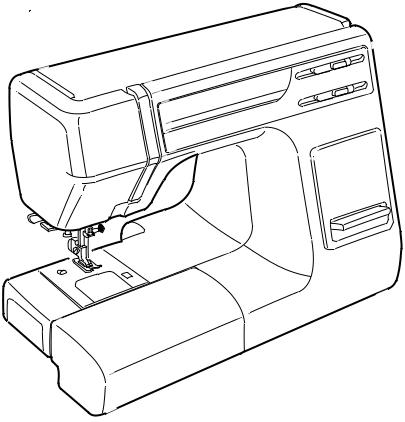
INSTRUCTIONBOOK

IMPORTANT SAFETY
INSTRUCTIONS
This appliance is not intended for use by persons (including children) with reduced physical, sensory or mental capabilities, or lack of experience and knowledge, unless they have been given supervision or instruction concerning use of the appliance by a person responsible for their safety.
Children should be supervised to ensure that they do not play with this sewing machine.
When using an electrical appliance, basic safety precautions should always be followed, including the following:
This sewing machine is designed and manufactured for household use only. Read all instructions before using this sewing machine.
DANGER— To reduce the risk of electric shock:
1.An appliance should never be left unattended when plugged in. Always unplug this sewing machine from the electric outlet immediately after using and before cleaning.
2.Always unplug before replacing a sewing machine bulb. Replace bulb with same type rated 15 Watts.
WARNING—To reduce the risk of burns, fire, electric shock, or injury to persons:
1.Do not allow to be used as a toy. Close attention is necessary when this sewing machine is used by or near children.
2.Use this appliance only for its intended use as described in this ownerʼs manual.
Use only attachments recommended by the manufacturer as contained in this ownerʼs manual.
The design and specifications are subject to change without a prior notice.
3.Never operate this sewing machine if it has a damaged cord or plug, if it is not working properly, if it has been dropped or damaged, or dropped into water.
Return this sewing machine to the nearest authorized dealer or service center for examination, repair, electrical or mechanical adjustment.
4.Never operate the appliance with any air opening blocked. Keep ventilation openings of this sewing machine and foot controller free from accumulation of lint, dust and loose cloth.
5.Never drop or insert any object into any opening.
6.Do not use outdoors.
7.Do not operate where aerosol (spray) products are being used or where oxygen is being administered.
8.To disconnect, turn all controls to the off (“O”) position, then remove plug from outlet.
9.Do not unplug by pulling on cord. To unplug, grasp the plug, not the cord.
10.Keep fingers away from all moving parts. Special care is required around the sewing machine needle.
11.Always use the proper needle plate. The wrong plate can cause the needle to break.
12.Do not use bent needles.
13.Do not pull or push fabric while stitching. It may deflect the needle causing it to break.
14.Switch this sewing machine off (“O”) when making any adjustment in the needle area, such as threading the needle, changing the needle, threading the bobbin or changing the presser foot, and the like.
15.Always unplug this sewing machine from the electrical outlet when removing covers, lubricating, or when making any other adjustments mentioned in this ownerʼs manual.
SAVE THESE INSTRUCTIONS
Please note that on disposal, this product must be safely recycled
in accordance with relevant National legislation relating to
 electrical/electronic products. If in doubt please contact your retailer for guidance. (European Union only)
electrical/electronic products. If in doubt please contact your retailer for guidance. (European Union only)
1
Do’s and Don’ts
1.Always be aware of the up-and-down movement of the needle and do not turn your attention from the machine while it is running.
2.When leaving the sewing machine unattended, the main switch of the machine must be switched off or the plug must be removed from the socket-outlet.
3.When servicing the sewing machine, or when removing covers or changing lamps, the machine must be disconnected from the supply by removing the plug from the socket-outlet.
4.Do not place anything on the foot control, otherwise the machine will start inadvertently, or the control or motor may burn out.
5.The maximum permissible power for the sewing lamp bulb is 15 watts.
6.When using your sewing machine for the first time, place a piece of waste fabric under the presser foot and run the machine without thread for a few minutes. Wipe away any oil which may have appeared.
2
TABLE OF CONTENTS
SECTION I ESSENTIAL PARTS |
|
Names of Parts ............................................................................................ |
4~5 |
Foot Storage Compartment ............................................................................. |
6 |
Extension Table(Accessory Storage Box) ...................................................... |
7 |
SECTION II GETTING READY TO SEW |
|
Connecting the Machine to the Power Supply ................................................ |
8 |
Foot Control ..................................................................................................... |
9 |
Sewing Light .................................................................................................... |
9 |
Pressure Dial ................................................................................................. |
10 |
Dropping the Feed Dogs ............................................................................... |
10 |
To Snap On and Snap Off the Preser Foot................................................... |
11 |
To Detach and Attach the Foot Holder ......................................................... |
12 |
Reverse Stitch Button.................................................................................... |
12 |
Seam Guide Line ........................................................................................... |
12 |
Changing Needle ........................................................................................... |
13 |
Thread and Needle Chart .............................................................................. |
14 |
Winding the Bobbin ................................................................................. |
15~17 |
Threading the Machine.................................................................................. |
18 |
Needle Threader.......................................................................................... |
..19 |
Drawing Up Bobbin Thread ........................................................................... |
20 |
Balancing Needle Thread Tension ................................................................ |
21 |
Pattern Selector Dial ..................................................................................... |
22 |
Zigzag Width Control ..................................................................................... |
22 |
Stitch Length Control ..................................................................................... |
22 |
Variable Needle Position ............................................................................... |
22 |
SECCTION III BASIC SEWING |
|
Straight Stitch Sewing ................................................................................... |
23 |
Changing the Sewing Directions ................................................................... |
24 |
Straight Stitching on Heavy Fabrics .............................................................. |
24 |
Zigzag Stitch .................................................................................................. |
25 |
SECCTION IV UTILITY STITCHING |
|
Overcasting.................................................................................................... |
25 |
Overedge Stitch ............................................................................................. |
26 |
Tricot Stitch.................................................................................................... |
26 |
Triple Strength Stitich .................................................................................... |
27 |
Outline Stretch Stitich .................................................................................... |
27 |
Sewing Buttons.............................................................................................. |
28 |
Automatic Buttonhole .............................................................................. |
29~31 |
Manual Buttonhole................................................................................... |
32~33 |
Corded Buttonhole......................................................................................... |
34 |
Zipper Application .................................................................................... |
35~37 |
Rolled Hem .............................................................................................. |
38~39 |
Blind Stitch Hemming .................................................................................... |
40 |
SECCTION V DECORATIVE STITCHING |
|
Decorative Satin Stitch Patterns ................................................................... |
41 |
Stretch Stitch Patterns................................................................................... |
41 |
Adjusting Stretch Stitch Balance ................................................................... |
42 |
Smocking ....................................................................................................... |
42 |
Quilting........................................................................................................... |
43 |
Pin Tucking .................................................................................................... |
44 |
Shell Tuck ...................................................................................................... |
45 |
Fagoting ......................................................................................................... |
45 |
Applique ......................................................................................................... |
46 |
Patch Work .................................................................................................... |
46 |
SECCTION VI CARE OF YOUR MACHINE |
|
Cleaning the Bobbin Holder .......................................................................... |
47 |
Cleaning the Hook Race ............................................................................... |
48 |
Inserting the Bobbin Holder........................................................................... |
48 |
Trouble Shooting ..................................................................................... |
49~50 |
3
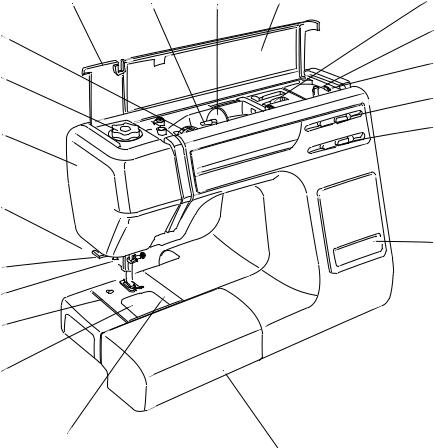
Names of Parts
q Stitch length control w Zigzag width control e Bobbin winder stopper r Bobbin winder spindle
t Foot storage compartment
y Flip-top sewing instruction panel u Spool holder (large)
i Spool pin o Top cover
!0Thread tension dial !1Pressure dial !2Face plate !3Buttonhole lever !4Thread cutter !5Needle threader !6Needle plate !7Hook cover plate
!8Hook cover plate release button Extension table
!9(Accessory storage box) @0Reverse stitch button
SECTION I ESSENTIAL PARTS
o |
i u y |
t |
!0 |
|
r |
|
|
|
!1 |
|
e |
|
|
|
|
|
w |
!2 |
|
q |
|
|
!3


 @0 !4
@0 !4 

 !5
!5 
 !6
!6
!7
!8
!9
4
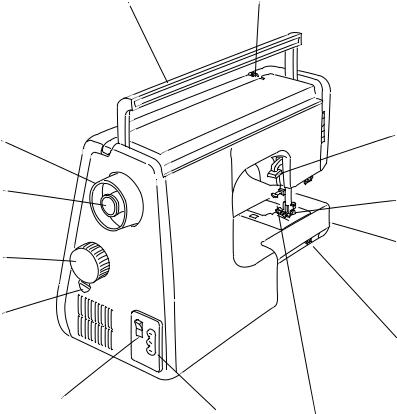
@1 @0
@2 |
|
|
#2 |
@3 |
|
|
#1 |
|
|
|
|
@4 |
|
|
#0 |
|
|
|
|
@5 |
|
|
|
|
|
|
@9 |
|
@6 |
@7 |
@8 |
|
|
||
|
|
|
@0Thread take-up lever @1Carrying handle @2Handwheel @3Clutch knob @4Pattern selector dial @5Feed balance dial @6Power switch @7Machine socket @8Needle clamp screw @9Drop feed lever #0Free arm #1Presser foot #2Presser foot lifter
5
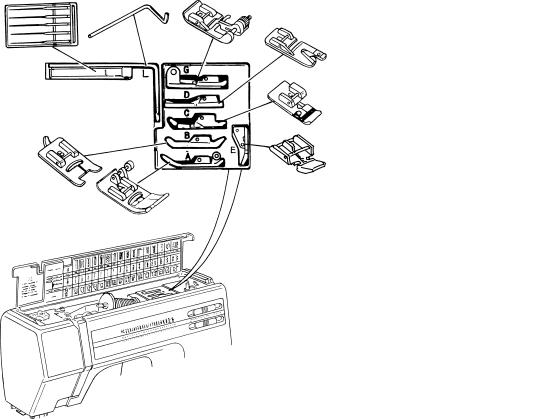
Foot Storage Compartment
q |
|
|
Each presser foot and pocket is lettered for easy |
w |
e |
identification and storage. To achieve optimum |
|
|
|
sewing results, use the foot recommended for |
|
|
|
|
|
|
|
r |
each sewing technique. |
|
|
t |
q Needle case |
|
|
w L. Quilter |
|
|
|
|
|
|
|
|
e G. Blind stitch hem foot |
|
|
y |
r D. Hemmer foot |
|
|
t C. Overedge foot |
|
|
|
|
|
u |
|
|
y E. Zipper foot |
|
|
|
u B. Transparent buttonhole foot |
|
i |
|
i A. Zigzag foot |
|
|
|
o R. Automatic buttonhole foot |
|
|
|
o |
* The automatic buttonhole foot can be stored in the extension table.
6

Extension Table (Accessory Storage Box)
Extension Table |
Accessory storage box |
The extension table provides added sewing surface and can be easily removed for free arm sewing.
¡ Sewing accessoires are conveniently located under the extension table.
For free arm sewing |
For attaching the table |
Lift out the extension table, as illustrated .
Position the two pins of the storage box on the base slit and push down gently.
7
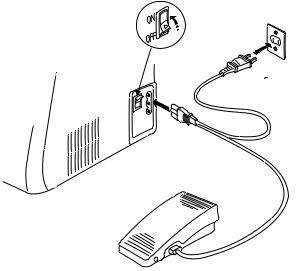
SECTION II GETTING READY TO SEW
Connecting the Machine to the Power Supply |
Before connecting the power, make sure the voltage and frequency of your |
|
|
|
electrical power conform to the machine. |
|
Switch off the power, fit the nonreversible plug into the machine socket and |
|
plug the machine into the power supply. |
|
Switch on the power. |
|
While in operation, always keep your eyes on the sewing area, and do not |
|
touch any moving parts such as the thread take-up lever, handwheel |
|
or needle. |
|
Always turn off the power switch and unplug from the power supply: |
|
- when leaving the machine unattended. |
|
- when attaching or removing parts. |
|
- when cleaning the machine. |
|
Do not place anything on the foot control, otherwise the machine will |
|
run intermittently. |
|
Operating Instructions: |
|
The symbol "O" of a switch indicates the "off" position of a switch. |
|
For an appliance with a polarized plug (one blade wider than the other): |
|
To reduce the risk of electrical shock, this plug is intended to fit in a |
|
polarized outlet only one way. |
|
If it does not fit fully in the outlet, reverse the plug. If it still does not fit, |
|
contact a qualified electrician to install the proper outlet. |
|
Do not modify the plug in any way. |
|
The foot controller Model YC-482J or TJC-150 is used with this sewing |
machine (USA market only).
8

Foot Control |
Sewing Light |
Sewing speed can be varied by the foot control. The harder you press on the control, the faster the machine runs.
The sewing light is located behind the face plate.
[To replace the bulb] |
|
|
(A) |
• To remove......... |
Turn to the left. |
|
• To replace......... |
Turn to the right. |
(B) |
• To remove......... |
Push and twist to |
|
• To replace |
the left. |
|
Push and twist to |
|
|
|
the right. |
NOTE: When replacing the bulb, unplug the machine.
9
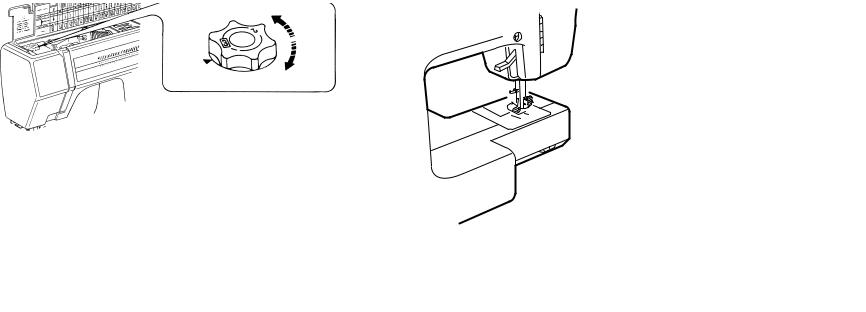
Pressure Dial |
Dropping the Feed Dogs |
The pressure dial should be set at “3” for regular sewing. Reduce the pressure to “2” for appliques.
Set the pressure to “1” when sewing chiffon, lace, organdy and other fine fabrics. Velours and knits with a lot of stretch may also require a “1” setting.
* Feed dogs must always be up for normal sewing.
10

To Snap On and Snap Off the Presser Foot
To snap off |
|
|
|
|
To snap on |
Additional Clearance |
|||
|
|
|
|
|
|
|
|
|
|
|
|
|
|
|
|
|
|
|
|
Turn the handwheel toward you to raise the needle to its highest position. Raise the presser foot.
Press the lever on the back of the foot holder.
The presser foot will drop off.
When attaching the presser foot, the pressure dial should always be at position “3”.
Place the presser foot so the pin on the foot lies just under the groove of the foot holder. Lower the foot holder to lock the foot in place.
The presser foot can be raised higher for additional clearance.
11

To Detach and Attach the Foot Holder
To Detach |
To Attach |
Reverse Stitch Button |
Seam Guide Line |
Remove the thumb screw by turning the screw counter-clockwise with the screwdriver.
Align the hole in the foot holder with the threaded hole in the presser bar and fit the foot holder screw into the hole. Tighten the screw by turning it clockwise.
As long as you keep the reverse stitch button depressed, the machine sews backwards.
|
5/8 |
|
6 |
15 |
/8 |
20 |
|
The numbers on the needle plate indicate the distance between the left needle position and the line.
The numbers in the front indicate in millimeters.
The numbers in the back indicate in inches.
12
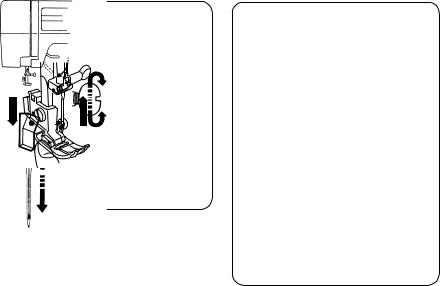
Changing Needle
Raise the needle by turning the handwheel toward you and lower the presser foot.
Turn off the power switch.
Loosen the needle clamp screw by turning it counter-clockwise.
Remove the needle from the clamp.
Insert the new needle into the needle clamp with the flat side away from you.
When inserting the needle into the clamp, push it up as far as it will go and tighten the clamp screw firmly with the screwdriver.
*Check your needles frequently for barbed or blunted points. Snags and runs in knits, fine silks and silk-like fabrics are permanet and are almost always caused by a damaged needle.
13
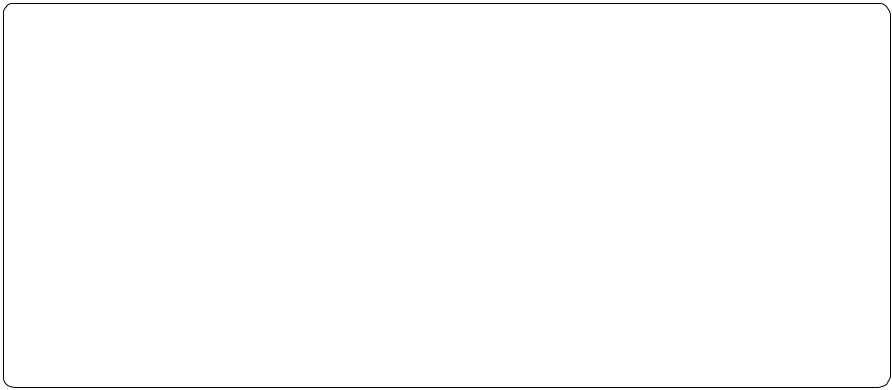
Thread and Needle Chart
|
Fabrics |
Threads |
Needle Size |
|
|
|
|
|
|
Light |
Crepe de Chine, Voile |
Fine Silk |
9 |
|
weight |
Lawn, Organdy, Georgette, Tricot |
Fine Cotton |
or |
|
|
11 |
|||
|
|
Fine Synthetic |
||
|
|
|
||
|
|
Fine Cotton Covered Polyester |
|
|
|
|
|
|
|
Medium |
Linens, Cotton, Pique, |
50 silk |
11 |
|
or |
||||
weight |
Serge Double Knits, Percale |
50 to 80 Cotton |
||
14 |
||||
|
||||
|
|
|
||
|
|
50 to 60 Synthetic |
|
|
|
|
Cotton Covered Polyester |
|
|
|
|
|
|
|
Heavy |
Denim, Tweed, Gabardine, |
50 silk |
14 |
|
weight |
Coating, Drapery and Upholstery Fabric |
40 to 50 Cotton |
or |
|
|
|
16 |
||
|
|
40 to 50 Synthetic |
||
|
|
|
||
|
|
Cotton Covered Polyester |
|
|
|
|
|
|
•In general, fine threads and needles are used for sewing thin fabrics, and thicker threads and needles are used for sewing heavy fabrics. Always test thread and needle size on a small piece of fabric which will be used for actual sewing.
•Use the same thread for needle and bobbin.
•When sewing stretch, very fine fabrics and synthetics, use a BLUE TIPPED needle. The blue tipped needle effectively prevents skipped stitches.
•When sewing very fine fabrics, sew over a piece of paper to prevent yarn distortion.
14

Winding the Bobbin
Horizontal Spool Pin |
Additional Spool Pin |
Removing the Bobbin |
Ordinary Spool
Small Spool
Lift up the spool pin. Place the spool of thread on the spool with the thread coming off the spool as shown.
Attach the large spool holder pressing it firmly against the thread spool.
* The small spool holder is used with narrow or small thread spools.
The additional spool pin is used to wind extra bobbins without unthreading the machine.
To use, insert the additional spool pin in the hole. Place the felt and the spool on the pin.
Gently slide the hook cover plate release button to the right, and remove the cover plate.
Lift out the bobbin.
15
